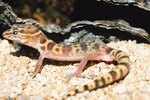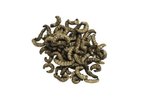
Contrary to what their name might suggest, mealworms are not worms, but rather the larvae of the darkling beetle. Mealworms are light brown and darken as they get older. Young mealworms are from half an inch to three-quarters of an inch long, and grow to as long as 1-1/4 inches when full-grown. Mealworms are food-motivated, and will subsist in any environment that provides them with a reliable food source.
Call of the Wild
The call of the wild does not really beckon mealworms. If no other food source is available to them, they will seek out moist, dark places, such as beneath rocks or rotten logs and in animal burrows. Mealworms in the wild will eat decaying leaves and wood, dried grasses and grains. They strongly prefer human environments, however.
Human Environs
Human environments are far more suitable to a mealworm’s need. Because food doubles as habitat for mealworms, mills, warehouses, grocery stores and farms are ideal habitats for these scavengers. Such places tend to have stored grains, which doubles as food and habitat for mealworms. They bury themselves in about 3 inches of crushed wheat bran, for example, and live in the very substance they also consume. They also get their water from potatoes and apples.
In Captivity
Because mealworms are a food source for small mammals, reptiles, birds and fish, some people will raise them. Mealworms can thrive in captivity, and can be purchased at pet shops. A clean, plastic storage container with air holes pre-drilled or drilled in is ideal, although a shoe box with air holes also will do. Temperatures should be kept on the warm side. Mealworms are resilient but thrive at temperatures between 70 and 80 degrees F. Fill the container with wood shavings, rocks, mulch, dried leaves and sticks – anything the mealworm can use to bury itself beneath. Feed them oats and pieces of apple.
Your Trash, the Mealworm's Treasure
Insects will be insects, and the mealworm is not picky. Therefore, mealworms often are found in areas where excess biological waste has accumulated. Unsavory though it is, waste offers the mealworm a dark, moist place under which to bury itself and plenty of water-rich food to keep itself fed for a long time.
References
Photo Credits
-
Hemera Technologies/PhotoObjects.net/Getty Images
Writer Bio
Vivian Gomez contributes to Retailing Today, the Daily Puppy, Paw Nation and other websites. She's covered the New York Comic Con for NonProductive since 2009 and writes about everything from responsible pet ownership to comic books to the manner in which smart phones are changing the way people shop. Gomez received her Bachelor of Arts in English literature from Pace University.




